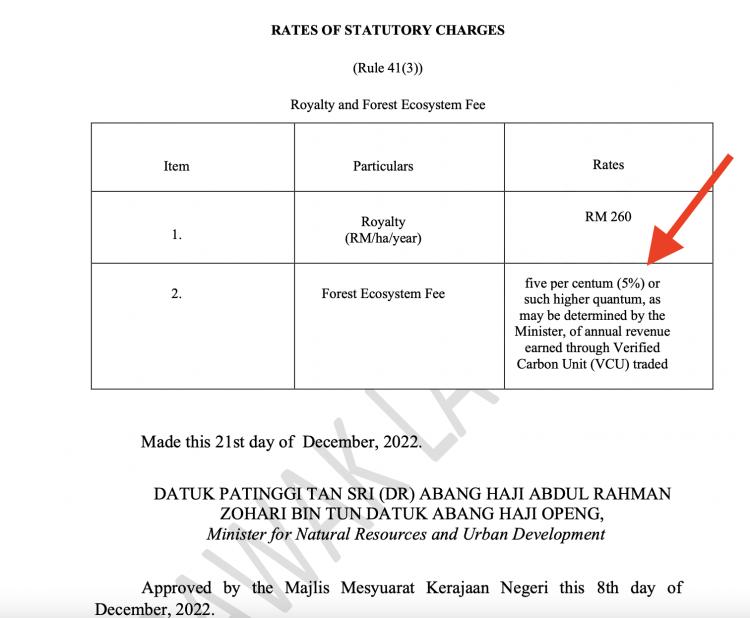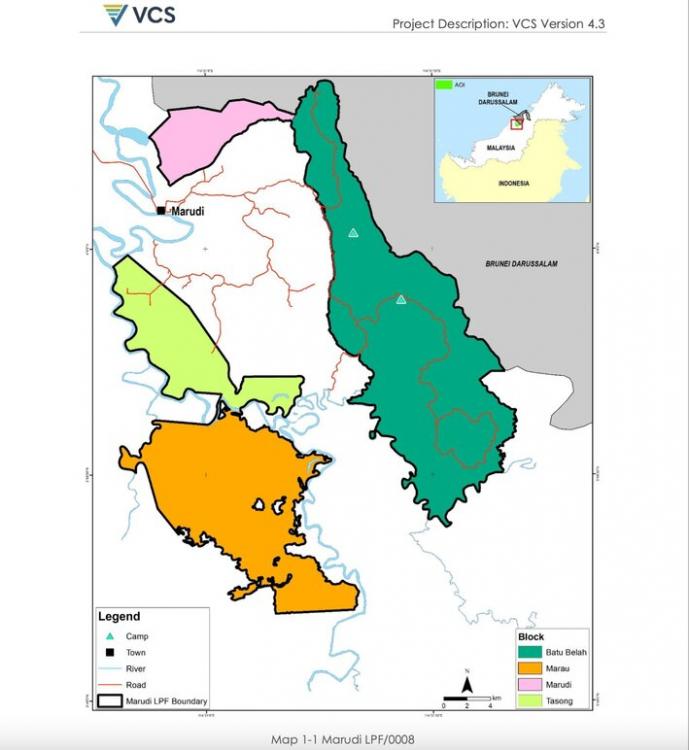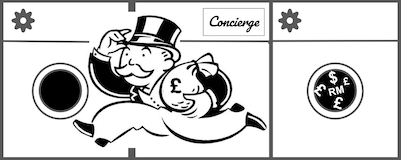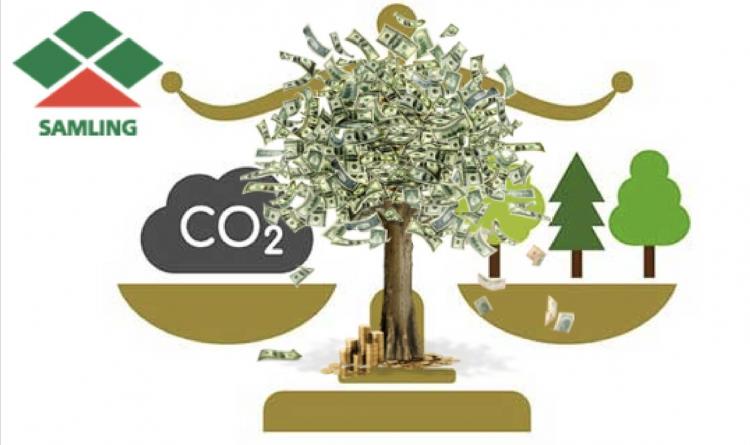Samling’s pilot carbon credit project, sanctioned under new legislation by the state government, could make billions for the company but represents extremely poor value for the public say experts.
The Marudi Forest Conservation and Restoration Project (MFCRP) under the timber giant’s special purpose subsidiary, SaraCarbon, is currently being assessed by the controversial Verra accreditation agency for the voluntary carbon credit market, targeting top level profits of up to $2 billion for the 39,000 hectare project over 60 years.
Yet under the state government’s own forest carbon activity ordinance, the scheme provides for a mere 5% government levy plus RM260 ($55) per hectare royalty, meaning that were $2bn raised by the company the public revenue would only be a fraction of around $230m.
This in return for allowing the conversion and extension of four half expired and poorly producing plantation licences into a further 60 years of profit for “essentially doing nothing’ out of native lands.
The easy bounty, gifted to a company amongst the most responsible for destroying Sarawak’s environment over the past 50 years, raises questions about the continuing influence of the timber tycoons over a state government that, ironically, is agitating for ‘absolute autonomy’ over the environment.

5% baseline levy under the 2022 Forest Ordinance approving carbon credit schemes for Sarawak
Corporate Capture alive and well in Sarawak?
The unequal bargain follows a pattern that has existed for decades, with the GPS government yet again favouring powerful timber barons over the people of the state.
Simon Counsell, an expert on carbon offsetting, has told Sarawak Report the SaraCarbon proposal, which seeks to convert 39,000 hectares of an original 55,000 hectares of planted forest licences dating from 1998, stands out even in the rapidly developing voluntary carbon industry which is plagued by cowboys.
“In what looks like a blatant mechanism to maximise the profit of corporations, the government tax on carbon credit sales is set at a mere 5%, many times lower than other governments are setting in their own legislation”.
He adds that “the proposed 60-year crediting period is long for this kind of project” – another dollop of jam for the crony company?
Another expert, Chris Lang, whose website REDD Monitor has critiqued the wider problems with monetising conservation through the market place, agrees:
“A 5% levy is ridiculously low. In August 2023, the government of Zimbabwe passed a regulation to ensure that forest carbon project developers pay a 30% environmental levy for the first decade of the project. This followed the scandal of the Kariba REDD project in the country, where only a small fraction of the money from the project went to local communities.
Lang also questions the dubious projection that Samling would have been able to complete the current plantation over the remainder of the existing 60 year licence, when so far they have planted less than fifth.
“Samling got the LPF licence in December 1998 – about 25 years ago. In all that time, they have managed to plant only 9,189 hectares with acacia.That’s about 368 hectares per year. Obviously, the acacia plantation idea is not going particularly well.Yet Samling claims it can generate 1,765,482 carbon credits per year by not converting 31,707 hectares of logged over forest to acacia plantations and reforesting 608 hectares.At the current rate of conversion it would take Samling 86 years to establish 31,707 hectares of acacia.Samling is inflating the baseline (i.e. massively exaggerating the story about what would happen in the absence of the carbon credits project).
That means that the project will result in yet more junk carbon credits in a voluntary carbon markets that is already flooded with junk credits.”
Samling is therefore plainly seeking to profit from a failing project through a sweetheart deal with the state government at the expense of the public. Why are they getting away with it?
Totting up The VCU Billions Eyed By Samling
Thanks to the generous terms and the grant of an extended licence, Samling is eying massive returns out of these native lands simply for not carrying out their original failed remit.
In their preliminary carbon credit proposal, filed with Verra on 16th November 2023, the company’s subsidiary SaraCarbon has estimated that, through a combination of credit building actions (avoided deforestation, reforestation and wetland protection), the four component areas included in project will reduce by 117,698,804 million tons the amount of climate changing carbon that would have been generated had the plantation project continued.
From these figures they hope to qualify for a phenomenal number of so-called Verified Carbon Units (VCUs), totalling 106 million over the course of the 60 year extended project, with an average annual production of 1,765,482 VCUs per year, each potentially worth several dollars each.
However, there is little basis for the claim says Chris Lang:
“It is a huge projection and would generate a vast number of carbon offsets from a relatively small area. The project document doesn’t seem to come up with any explanation how that figure was arrived at.”
The scepticism is shared by Simon Counsell who warns the project is still at an early stage of verification:
“This is an extremely high level [of VCUs], equivalent to more than 3,000 tons/hectare… it almost certainly mostly rests on assumptions primarily about the peat swamp areas, as these are the only ecosystems on Earth that contain anything like such high stocks of carbon.
It will likely assume Samling would have completely destroyed what must be peat deposits of probably at least three metres in depth.”
At the time the project was launched in 2021 the price per VCU was $15 representing a potential for Samling to earn $26 million a year according to its own figures, says Counsell:
This would potentially value the project’s gross revenues over its lifetime at somewhere between $0.5 billion and maybe $2 billion – all for essentially doing nothing on a very small part of the company’s overall holdings.
Yet the public revenue would only receive the 5% levy and modest royalty ($150-$230m).
Meanwhile the VCU market has imploded since the SaraCarbon proposal was given the go-ahead by Samling bosses in 2021, following a series of exposes about the cowboy nature of the voluntary carbon market and indeed Verra itself:
“values of these kinds of credits have crashed – not the least because of media exposes of how worthless they really are in terms of helping mitigate climate change. Instead of $15/t, a more likely current value would probably be around $0.50-$1.00/t”
warns Counsell, meaning the worth of the government levy could turn out to be almost negligible.
Observers further highlight the failures of the present proposal to detail what, if any, investment the giant timber company intends to make towards reforestation or active conservation in return for the billions it seeks to earn, let alone how locals might benefit in terms of revenue, development or jobs.
The Swiss environmental group BMF has visited the area and reports that communities have been left confused by so-called education sessions conducted by the company.
“The visited community expressed that they still did not comprehend the concepts of climate change and carbon trading after the session with Samling. Consequently, they did not understand the purpose of the carbon project affecting them.
After some explanations of the idea behind it, they criticized that this is yet anothor mechanism for companies to profit from Indigenous land.
BMF is very worried that Samling is repeating its mistakes in community engagement yet again. Historically, the company has repeatedly failed to properly consult communities affected by their extractive activities.”
Annina Aeberli, a senior campaigner for the fund told Sarawak Report.

SaraCarbon Project in Marudi combines 4 separate plantation licences handed to the giant concessionaire in 1998 [Verra project proposal]
Concerns
Many will question why the state government is continuing to reward companies who have already exploited the native people and their forests and are responsible for the careless destruction (first through logging then plantations) that has caused the climate change that the carbon market was set up to counter in the first place?
“Samling got the concession from Taib – and has already profited from logging the forest. The company should (in an ideal world) be penalised for the destruction it has already caused, and for its corrupt relationship with Taib.
Instead, having logged the living daylights out of the forest, Samling decided to clear what’s left and convert it to acacia plantations.
But in 2021, after 23 years of establishing plantations, Samling concluded that the acacia is not growing particularly well. So the company is now attempting to cash in on the carbon that will be stored in the forest if the company stops trashing it.
Says Lang. Counsell agrees:
“[there are] strong moral arguments about whether a company responsible for mass environmental damage, carbon emissions and destruction of indigenous lands should now potentially profit hugely from what appear to be very limited measures to supposedly discontinue such practices.”
Even in the face of arguments that saving the forest by rewarding companies not to implement corrupt and destructive licences is a lesser evil, there is the further danger of so-called ‘leakage’ and concerns about verification when dealing with corporations like Samling who have been granted millions of hectares to destroy.
Claims are already being made that appear untrue, says Counsell. For example, SaraCarbon claims Samling has stopped clearance and plantation work on the target area since 2021. Indeed the proposal claims “No clearing or conversion has occurred within the last 10 years”.
Yet, according to Counsell:
Analysis of the project area using Global Forest Watch suggests the statement is inaccurate… [it] shows, there has been extensive deforestation since 2013 in the Marau and Tasong blocks of the licence area.
Leakage
Moreover, even if the logging now stops, Counsell explains that a common problem is that the company may simply shift its activities to another segment of the vast concessions that the Sarawak state government has favoured on this firm.
“Some of the largest offset projects probably have leakage as high as 100% …. it might be that, whilst profiting greatly from this offset scheme, Samling would simply carry our comparable destruction elsewhere. [with] the potential global environmental cost of 100 million possibly worthless carbon credits being put onto the carbon markets in the future, and thus arguably adding to the problem of climate change.“
How It Works:
Like all carbon credit projects the SaraCarbon proposal is based on persuading the verification agency Verra (which itself is highly conflicted by the fact it will earn a percentage from the project) that carbon emissions can be avoided and reversed by carbon capture if the project goes ahead.
The Marudi project has been developed out of 4 separate plantation concessions totalling 55,818 hectares that were granted to Samling under Abdul Taib Mahmud in 1998. So far only just over 10,000 ha have been planted and it is now proposed 39,167 of the remaining area be designated for this carbon capture scheme instead.
The incentive of carbon credits will then be awarded which can be purchased on the voluntary carbon market for restoring the land or even doing nothing instead of digging up and planting.
As an ‘added reward’ to stop Samling from planting the area (which it has so far failed to anyway owing to an apparent lack of profitability) this lucrative opportunity will be enhanced by the state government who have agreed to extend the company’s licence for another 30 years.
Corporate Capture
The Marudi project represents the first officially backed carbon credit scheme embarked on in Sarawak under the State Government’s Forest Ordinance passed in December 2022 to tap into the booming, if highly controversial, voluntary carbon market, set up to counter climate change.
Yet, with such generosity shown towards the multi-billionaire timber companies compared to the slim pickings for the people, the pursuit of this new ‘green’ resource sadly appears to be a mere continuance of the familiar pattern of the past 50 years.
Under Taib Mahmud virtually the entire land mass and all Sarawak’s resources were alienated from native customary rights and parcelled out for destruction to a handful of crony companies, including Samling.
These in turn fed enormous kickbacks which sustained the ruling coalition and a cadre of ‘political puppets’ who ran the state in the interests of those companies under the ‘iron hand’ of Taib Mahmud.
Remarkably little was raised in revenues out of the huge profits from those logging, plantation and mining concessions in order to bring benefit to the people whose lands were thus abused.
Promised development and utilities have been utterly neglected.
The rest of the money has disappeared abroad, although numerous assets have been identified by this website and others across the globe as belonging to the Taib family in a vast trove of unexplained wealth.
So, why under its new Premier has the state government chosen to continue to favour the same companies who have failed for decades to provide promised benefits as they snatched Sarawak’s resources?
Have these powerful, questionable businesses achieved an irreversible hold over the political parties whose re-election they have funded time and again – the phenomenon known as Corporate Capture?
If so, this sweetheart carbon credit deal, like all the other crony concessions of the past, represents nothing more than the next stage of resource grabbing on behalf of a billionaire corporate kleptocracy (‘Corporatocracy’) which appears to continue to hold the state government (and 80 out of 82 state assembly seats) under its control.
To repair the damage it is not more autonomy for that is therefore needed but rather strong government in the people’s interest.
Companies like Samling should be squeezed from the concessions they were unjustly awarded and where they have failed to deliver, rather than being rewarded.
ALL the profit from converting to carbon credits should instead be diverted to the public purse and used to repair the damage done by careless logging and to provide long delayed basic amenities to those communities who lost their native lands and rights.
For this the world would be happy to pay for legitimate Sarawak carbon credits.

